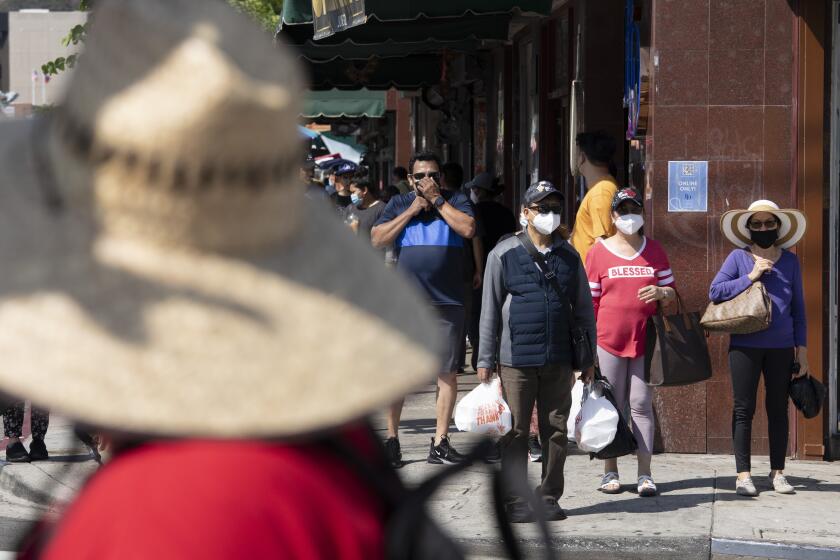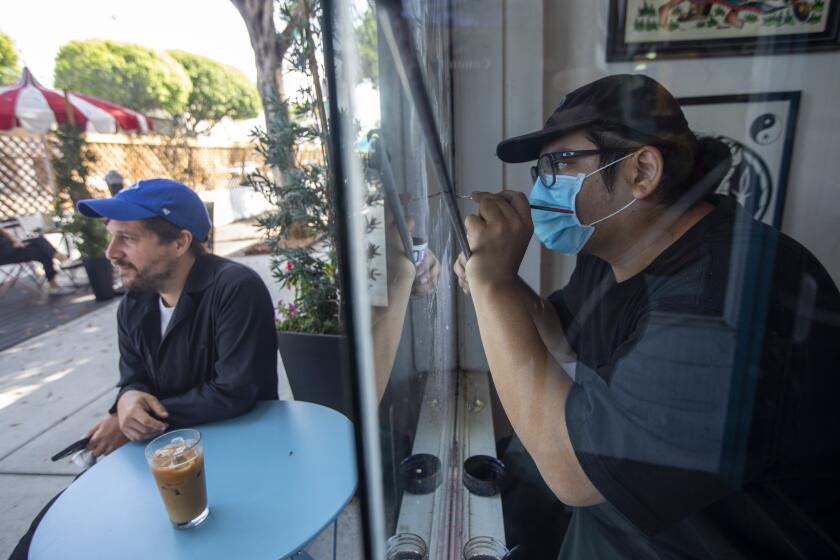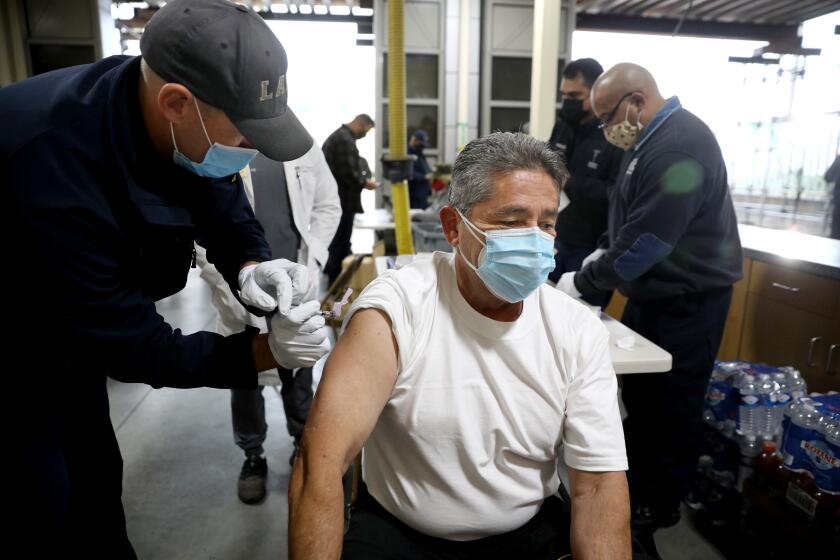L.A. County coronavirus spike hits alarming levels, with 10,000 infected in a week, as Delta variant spreads
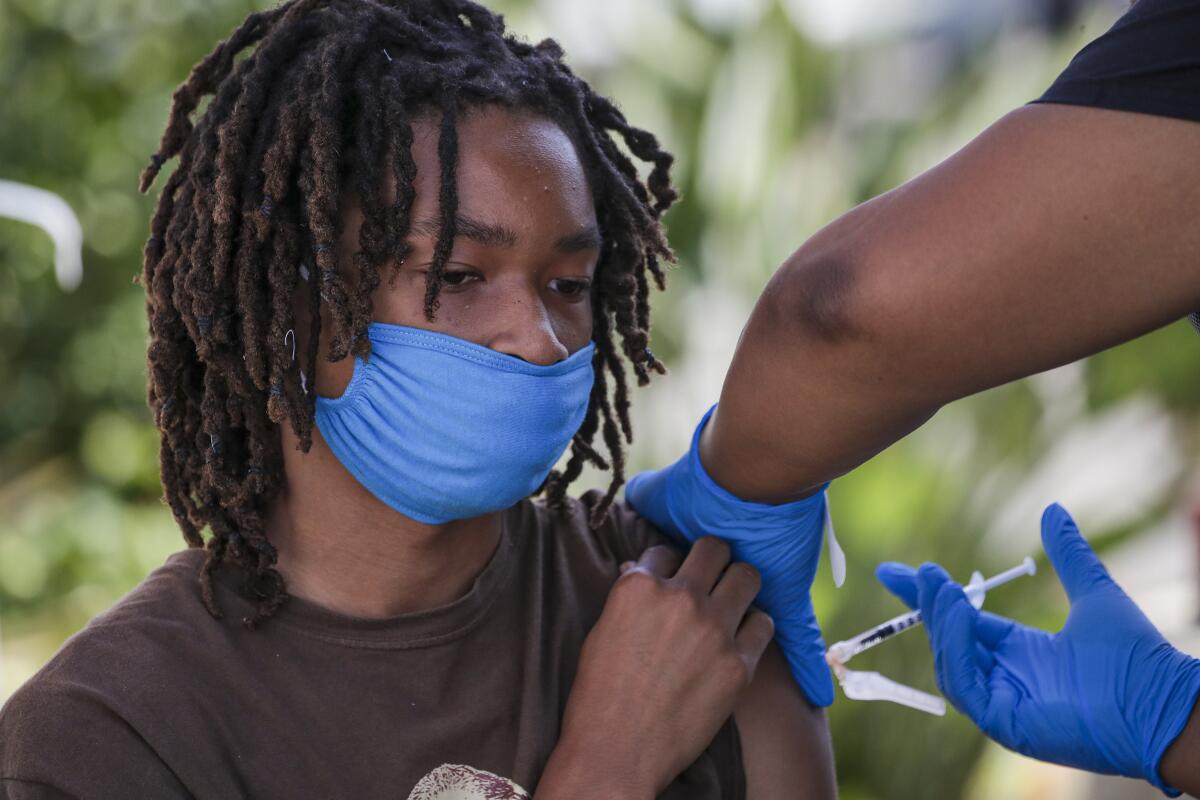
- Share via
Los Angeles County is now recording more than 10,000 coronavirus cases a week — a pace not seen since March — an alarming sign of the dangers the Delta variant poses to people who have not been vaccinated and heightening pressure on health officials to reverse the trend.
A Los Angeles Times data analysis found L.A. County was recording 101 weekly coronavirus cases for every 100,000 residents, up from 12 for the seven-day period that ended June 15. That means the county has surpassed the threshold to have “high” community transmission of the disease, the worst tier as defined by the U.S. Centers for Disease Control and Prevention. A region must hit 100 or more weekly cases per 100,000 residents to enter the worst tier.
It’s still far fewer than during the deadly winter surge, when L.A. County was recording more than 1,000 weekly cases for every 100,000 residents, but it underscores growing concerns that unvaccinated people are at heightened risk.
The rise here and elsewhere is the reason why 11 counties — home to more than half of Californians — are urging all residents regardless of vaccination status to wear masks in indoor public settings. So far, L.A. County is the only county to make it a requirement, while much of the San Francisco Bay Area, as well as Sacramento, Fresno and Yolo counties, have made the plea a recommendation.
Statewide, the number of coronavirus-positive patients in the hospital more than doubled in the last month, and the rate has climbed further in the last two weeks.
The primary rationale for a mandatory mask policy in indoor public settings is to get unvaccinated people to start wearing their masks again, reducing the risk of disease transmission until new infections decline.
Officials believe many unvaccinated people stopped wearing masks at the same time vaccinated people did so, even though uninoculated people are still under orders to continue wearing face coverings. Of new coronavirus cases in L.A. County over a recent six-month period, 99.6% involved people who have not been vaccinated.
COVID-19 hospitalizations in L.A. County have also doubled in the last three weeks, from 255 on June 28 to 528 on Saturday — a number not seen since April. That means the county is now reporting more than 5 people in the hospital for COVID-19 for every 100,000 residents, a threshold that some experts say could be a reasonable trigger for instituting stricter mask measures.
Other highly populated counties that have hospitalization rates above that threshold include San Bernardino, Alameda, Sacramento, Contra Costa, Fresno, San Joaquin, Stanislaus, Sonoma and Solano, according to The Times analysis.
L.A. County in part modeled its indoor mask order on Israel’s approach. Israeli authorities on June 25 reimposed mandatory mask requirements in indoor public spaces just 10 days after dropping most mask orders after observing a rise in infection rates. Government officials have been reluctant to impose a new lockdown order.
Promisingly, hospitalizations have remained relatively low in Israel, said Dr. Anthony Fauci, the U.S. government’s top infectious diseases expert, at a news briefing recently.
Fully vaccinated people are extraordinarily protected from severe disease, hospitalization and death from COVID-19, and experts across the nation say the worst effects of this surge are falling almost all on the unvaccinated. Unvaccinated people in L.A. County comprised 98.7% of COVID-19 hospitalizations and 99.8% of deaths between Dec. 7 and June 7, and not a single fully vaccinated person has been hospitalized for COVID-19 at L.A. County’s massive public hospital system.
“The hospitals will never be like how they used to be before,” said Dr. Peter Chin-Hong, infectious diseases expert at UC San Francisco.
About 53% of L.A. County residents are fully vaccinated, and 60% are at least partially vaccinated, but that still means there are millions of people who remain vulnerable to the ravages of COVID-19. Experts have guessed that 70% to 85% of a population will need to be immune to block ongoing transmission of the coronavirus.
Dr. Jerome Adams, former surgeon general, urged the CDC to hold up L.A. County’s mask policy as an example and advise masking up in communities with surging cases and rising rates of positive tests. “The emerging data suggests CDC should be advising to vax it AND mask it in areas with [rising] cases and positivity—until we see numbers going back down again,” Adams tweeted.
‘Anything is on the table if things continue to get worse, which is why we want to take action now,’ the L.A. County health officer said.
Federal officials have said L.A. County’s new order was reasonable. “And I anticipate that will happen in other parts of the country, too,” the current surgeon general, Dr. Vivek Murthy, said on ABC’s “This Week.”
Although vaccinated people are extraordinarily protected from severe COVID-19, they cannot completely ignore a rising rate of community transmission.
Increased circulation of the virus means that vaccinated people will be more likely to encounter an unvaccinated, contagious person in the community, and that means there’s a higher risk of a “breakthrough” infection. Breakthrough infections are already quite rare, but even if they do happen, it’s not likely that vaccinated people who are infected will need hospitalization.
Nonetheless, even a COVID-19 illness that doesn’t require hospitalization can still be disruptive to daily life, requiring notification of close contacts, canceling work activities and social life, and can be a “bummer,” Chin-Hong said.
“By increasing the virus in the community, you increase the chances that people who are vaccinated will get infected, and therefore spread it to unvaccinated people,” Chin-Hong said.
One-third of California counties are now urging even fully vaccinated people to wear masks indoors as coronavirus cases continue to rise.
It’s a reasonable assumption to make, however, that an infected vaccinated person will be less likely than an uninoculated person to pass the virus on to someone else, Fauci said. That’s because vaccinated people who are infected have considerably lower levels of virus in their throat compared with unvaccinated people.
Also, the best way to ensure children remain protected from COVID-19 is by having as many adults and teenagers around them as vaccinated as possible. L.A. County has 1.3 million children under the age of 12 who are too young to be vaccinated. And although young children are far less likely than adults to suffer severe complications of COVID-19 — because they have far fewer proteins called ACE2 receptors in their noses that the coronavirus needs to infect the body — there are nonetheless rare situations in which they can suffer severe illness and death.
Weekly coronavirus case rates have been highest and climbing fastest among the youngest adults, those age 18 to 29, according to county data; the virus is also spreading more quickly among adults in their 30s and 40s as well as teenagers compared with younger and older age groups.
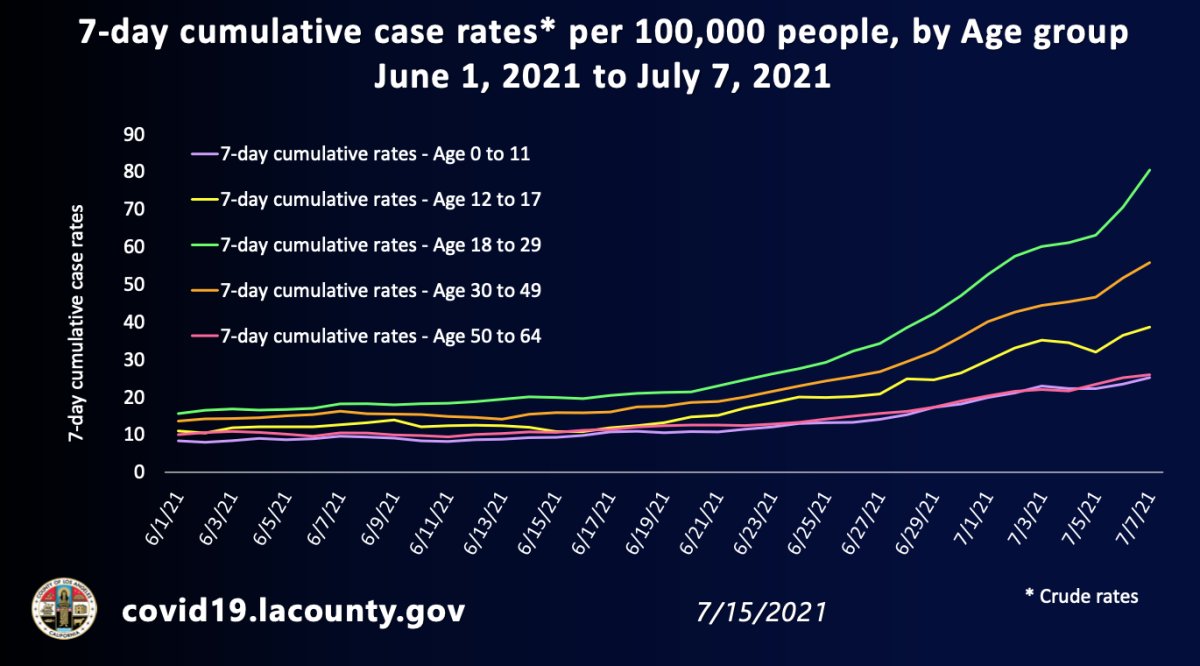
L.A. County officials estimate that 92% of residents age 65 to 79 have received at least one shot of vaccine. But only 41% of teens and adolescents age 12 to 15 are at least partially vaccinated, as are only 58% of the youngest adults, up to age 29.
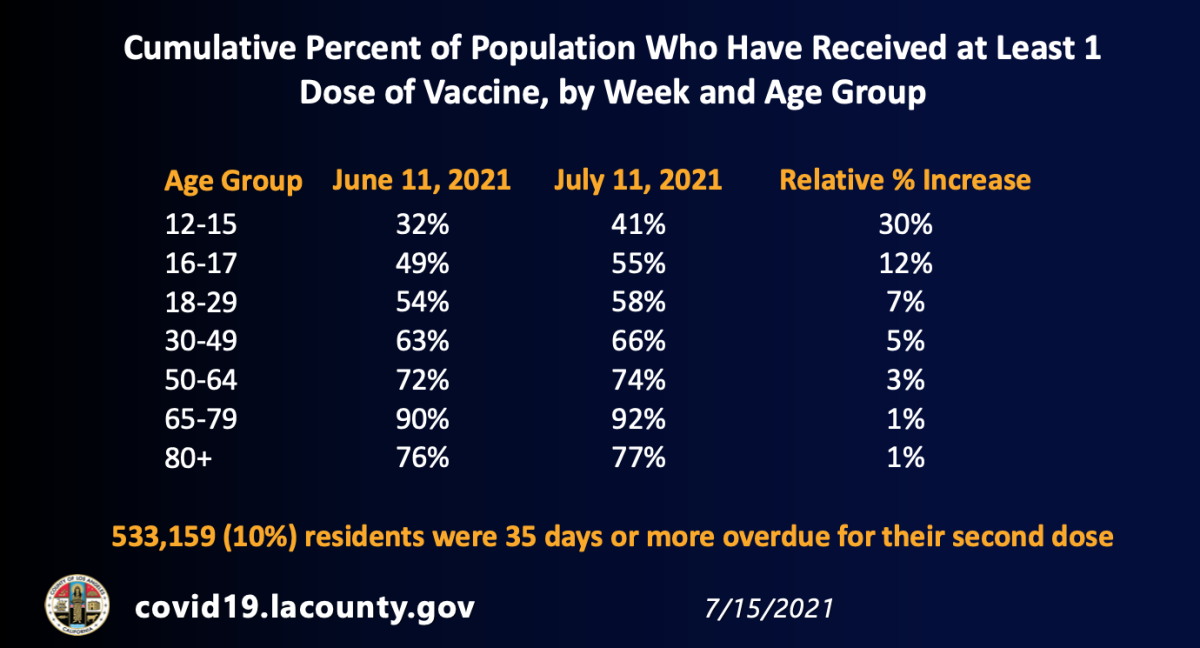
The rise in weekly coronavirus case rates, COVID-19 hospitalizations, or both has been noticeable in the four regions of California that have urged people to mask up again. The weekly coronavirus case rate has almost tripled in Sacramento County and nearly quadrupled in the nine-county San Francisco Bay Area in the last month.
Since July 4, the number of people hospitalized for COVID-19 has doubled in Sacramento County and risen by 51% in Fresno County. Hospitalizations in the Bay Area have doubled since late June.
The rise in cases comes as the pace of weekly vaccinations in L.A. County has fallen to disappointing rates, with about 80,000 first doses of shots administered per week in June, below the county’s goal of 100,000 first-dose shots a week. In May, Public Health Director Barbara Ferrer expressed optimism L.A. County could achieve herd immunity — which she guessed was 80% of residents age 16 and older with at least one shot — by the end of July. But at the current pace, that threshold might be achieved, at the earliest, only by December.
Younger Black and Latino residents are among those less likely to have received the shot than other demographic groups. Among those age 18 to 29, only 29% of Black and 43% of Latino residents have received at least one shot, while 59% of white, 60% of Native American and 77% of Asian Americans in that age group have received at least one dose.
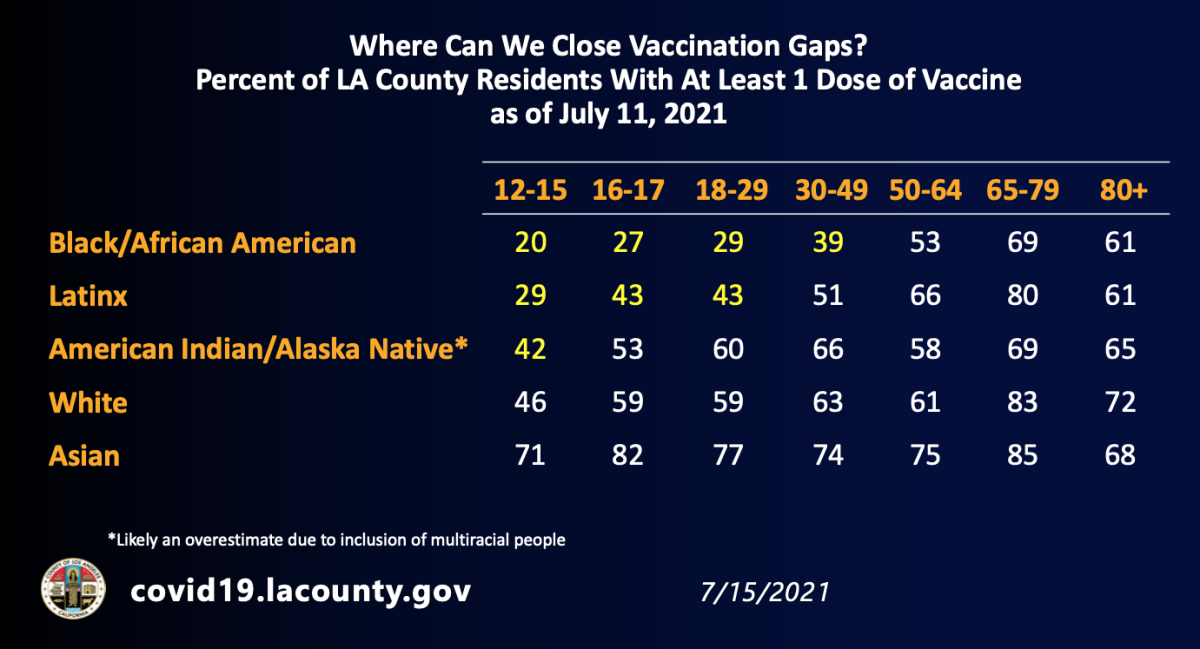
Experts say sending trusted people in communities to advocate for vaccinations at events and doing door-to-door outreach can help improve vaccination rates and access, offering people the chance to ask questions and enabling trained personnel to combat vaccine myths and misinformation. Getting vaccines into the offices of primary care physicians, where doctors can answer patients’ questions directly, can help too.
Another strategy would involve new requirements to get vaccinated, such as at workplaces.
Already, San Francisco has ordered all workers in “high-risk settings,” such as hospitals, nursing homes and residential facilities for the elderly, and jails, to be fully vaccinated by Sept. 15. San Francisco has also ordered all 35,000 of its city workers — including police, firefighters, custodians and clerks — to get vaccinated or risk losing their jobs once a vaccine has been formally approved by the U.S. Food and Drug Administration. The vaccines are currently distributed under an emergency use authorization. Exemptions to the vaccine requirement will be available for workers with valid religious and medical reasons.
Neither L.A. city or county officials have issued a similar order.
Los Angeles has reopened, but many first responders remain unvaccinated. Just over 50% of the city’s firefighters and police officers have gotten one shot.
The University of California has announced that COVID-19 vaccinations will be required for all students, staff and others before the fall term, becoming the nation’s largest public university system to mandate the vaccines even while they are distributed under an emergency use authorization.
One idea short of a mandatory vaccination order by employers is make it less convenient to remain unvaccinated, such as an order to get unvaccinated workers tested daily or at some other regular interval.
Times staff writers Luke Money, Teresa Watanabe and Colleen Shalby contributed to this report.
More to Read
Sign up for Essential California
The most important California stories and recommendations in your inbox every morning.
You may occasionally receive promotional content from the Los Angeles Times.
